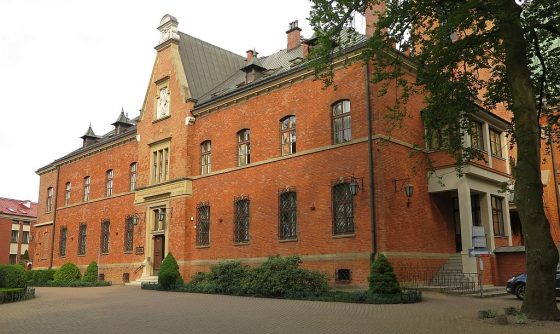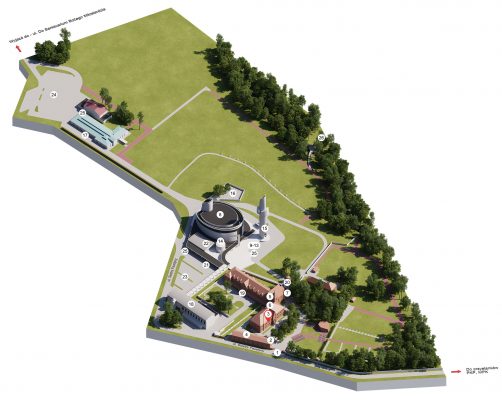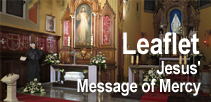We have put a map of the Shrine after the text.
Now we are in front of the convent building which has served as the Sisters’ living quarters since 1891. At the top of the façade there is a coat of arms with the Founder’s heraldic device (Szreniawa bez Krzyża, the arms of the Princes Lubomirski). Below is a bas-relief of Our Lady of Mercy, the chief patroness of the Congregation. An inscription in Polish at the first-floor level over the entrance door says that the building was founded by Prince Aleksander Lubomirski in 1890. Since 1893 this building has accommodated the novitiate, the Sisters’ dormitories, the kitchen and refectory (dining hall), the Congregation’s meeting hall, the speaking rooms where Sisters receive their guests, and the new porter’s lodge (reception). Practically all of these facilities, even the corridor and staircase, are silent testimonials of Sister Faustina’s meetings with Jesus, Lady, the Saints, the Souls in Purgatory, and even with God the Father. “I saw God looking on us with great pleasure,” (Diary 1439) she wrote of an apparition which occurred in the refectory. On another occasion, she took down these words Jesus said: “Today My Heart has reposed in this convent” (Diary 1074).
Sister Faustina spent nearly six years in this convent. She worked in the kitchen, the garden, and in the last year of her life on porter’s duty at the entrance gate and on telephone duty in the porter’s lodge next to enclosure (the enclosed premises out of bounds except for members of the Congregation). Her simple and ostensibly ordinary life carried an extremely rich and profound spiritual life hidden within her everyday matters. Through prayer and her mystical experiences she entered deeply into the mystery of God’s merciful love, discovering and tracing that love in the entire panorama of history, from the creation of the Angels, the world, and Man, through Jesus’ incarnation, His preaching, death, and resurrection, as well as in the Church He founded and endowed with the rich legacy of the Word of God and the Sacraments, right up to the Last Things, Heaven, Purgatory, and Hell, which has rejected God’s mercy. At Jesus’ request, she made a record of what she learned of these things in her Diary, which St. John Paul II called “The Gospel of Mercy,” and Cardinal John Tong Hon, Archbishop of Hong Kong, wrote in the preface to the Chinese edition of the Diary that it is “the most wonderful gift God has bestowed on the world, . . . a spiritual treasure for the entire Church.” Translated into scores of languages, the Diary of Sister Faustina has become an extremely popular bestseller worldwide because, as Jesus said, it was written to strengthen and comfort souls. For many it is a guide to spiritual life and a prayer book they read every day, second only to the Bible.
In her Diary Sister Faustina made a record not only of her road to unity with God, but also of the message of Mercy with which Jesus sent her to the world at large, reminding us of the Biblical truth of God’s merciful love for every human being and calling us to spread this message by witnessing to it with our lives, words and deeds, and in our prayers. An integral part of witnessing to that message are the devotions to the Divine Mercy which Jesus bequeathed to Sister Faustina. These specially privileged devotions are the Holy Picture with the inscription “Jesus, I trust in You,’ the Feast of the Divine Mercy, the Chaplet and the Hour of Mercy, and the spreading of the worship of Mercy.
The spiritual attitude at the very core of the worship of the Divine Mercy is absolute entrustment to God, in other words doing His will as enshrined in the Commandments, in the duties incumbent on the individual person in his or her station in life, in the Word of God, and in the inspirations the individual person receives from the Holy Spirit. This attitude of Biblical faith comes from knowing God in the mystery of His merciful love. The second important component of the worship of the Divine Mercy is doing acts of mercy to one’s neighbours, which makes it more than just a set of devotions, but actually promotes and develops the Christian way of life. These two features, entrustment in God and the dispensation of acts of mercy to one’s neighbours, lie at the foundation of the practice of each and every one of the devotions to the Divine Mercy, or in fact make up its very core, because trusting in God is the first step in the worship of the Divine Mercy, for it is to the trusting soul that Jesus has promised a special blessing: “Dearest to Me is the soul which firmly believes in My goodness and has put all its trust in Me; I bestow My confidence on it and grant everything it asks for” (Diary 453).
So we could summarise Sister Faustina’s spiritual life in just two words: entrustment and mercy. Entrustment defined her relationship with God by doing His will; while mercy with a small-case m described her relations with other people, whom she loved with a heroic love right to the point of offering her life up for them. “O my Jesus,” she prayed, “each of Your saints reflects one of Your virtues in himself; I want to reflect Your Heart, full of compassion and mercy, I want to sing Its praise. Let Your mercy be impressed like a seal on my heart and soul, O Jesus, and that shall be my badge in this life and in the life to come” (Diary 1242).
- Main entrance to the Shrine
- Sister Faustina’s House: hotel & museum
- Convent
- Antoninek House: Faustinum Association
-
Merciful Jesus Chapel & Saint Faustina’s Tomb: Heart of the Shrine
- Oratory: room where Saint Faustina died
- Chapel of the Lord’s Passion
- Divine Mercy Basilica
- Saint Faustina’s Chapel
- The Communio Sanctorum Chapel
- Saint Andrew’s Chapel
- The Holy Cross Chapel
- The Chapel of Our Lady of the Seven Sorrows
- Perpetual Adoration Chapel
- Viewing Tower
- Convent Graveyard
- Sister Faustina’s House: restaurant, souvenirs & meeting hall
- Pastoral Lodge: hotel & restaurant
- Mercy House
- Information Booth
- Souvenirs & Misericordia Bookshop
- Saint John Paul II Hall
- Car park
- Car and coach park
- Toilets
- Bridge of Mercy, for the Saint John Paul II Shrine & tram stop

















